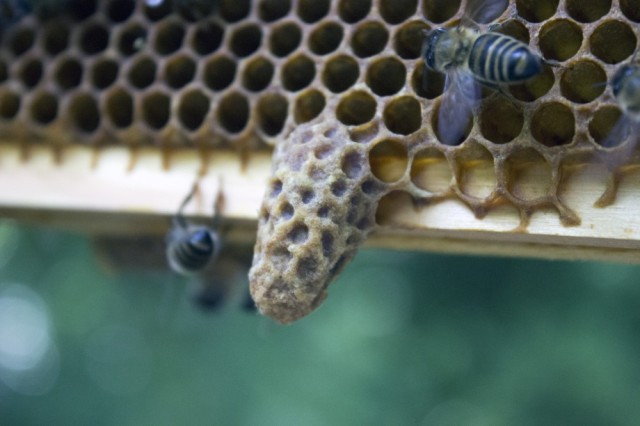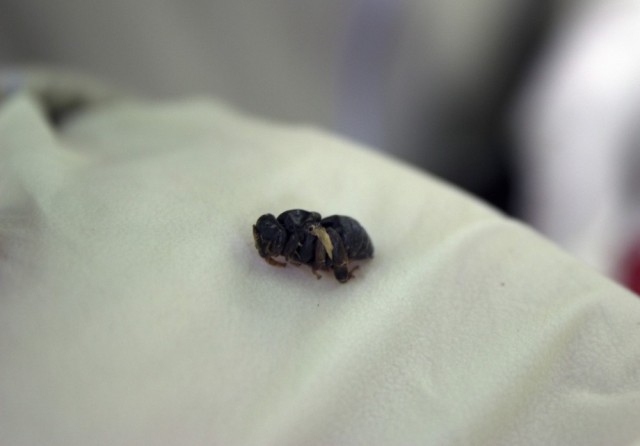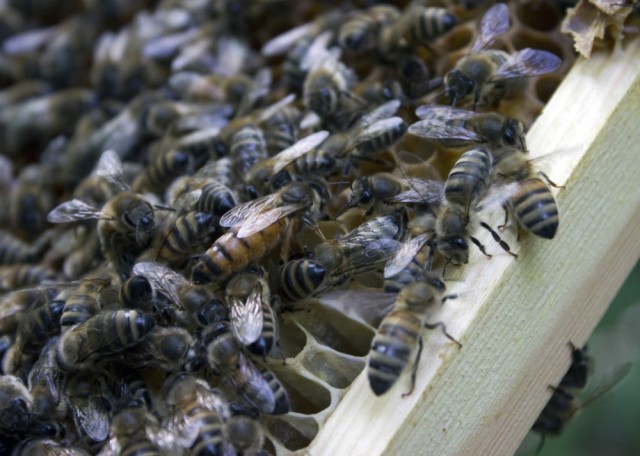I went to Albania and a lot happened while I was away! Our naughty queen Lavender decided to swarm when our backs were turned. And Emma had to put Queen Myrrh to rest and give her hive a new queen cell, because she had not managed to mate successfully amidst all the rain. Emma has a great blog post about all this action here: The Bad Beekeepers Club. Oh yes, something else that changed while I was away…the never-ending rain finally stopped, sunshine broke out here and rain came to Albania.
So we had a lot to do during our inspections yesterday. Emma has kindly let me use her brilliant photos here.
This was the queen cell Emma took from Lavender’s swarmed hive two weeks ago and put in Myrrh’s old hive. Alarm bells were ringing at the sight of it still being capped. It was already capped two weeks ago; the queen should emerge eight days after the cell is first capped. Sometimes the workers can keep adult queens trapped within the cell by thickening the wax topping, but that is generally done if the colony is considering throwing multiple casts, or after-swarms. That would not have been the case in this little hive.
We asked John Chapple’s advice. He instructed us to shake the bees off the frame and then gently cut the tip of the queen cell off with a hive tool to see what was inside. The queen revealed was obviously a goner, and had been for some time. “I’m no expert” (hah!) John said, “but that looks like black queen cell virus”. Having looked it up at home, this is a virus associated with the spore disease nosema, which is worrying. You can see her tattered wings and black body below.
Another odd thing was found within this hive; I gave Emma quite a jump when I held it up on my hand! It’s not a monster, merely a dead bumble bee I found on the floor of the hive. I asked John about it and he explained her black, shiny body was due to our bees having pulled all her hair off whilst attacking her. She was probably hungry and our bees didn’t take kindly to a robber. A sad ending for a beautiful beast.
It has now been over a month since this hive had a properly laying queen. We had wanted them to produce their own new queen rather than buying in a queen from a different climate, but the weather was against us and this attempt failed. We decided to combine the dwindling bunch of bees with our queen-right colony, using the newspaper method. This technique is much loved among beekeepers for its simplicity and cheapness, advantages close to all true beekeepers’ hearts.
Some newspaper is placed on top of the brood box you wish to add extra bees to. “It’s not the Times”, John commented. No indeed, it was my local free newspaper. That’s how cheap I am. Next, a few little holes can be made in the newspaper with a hive tool. Don’t go too crazy with the holes, as the idea is that the bees chew though the paper gradually and slowly become accustomed to each other’s smell, preventing fighting.
Ta-da! And so two hives become one. By the time we inspect next week they should have chewed through it all and become friends.
I should also introduce our new ruler in Lavender’s old hive. When her retinue decided to swarm and leave us, they left behind some queen cells, which Emma sensibly reduced down to two. I peeked in the hive last week and was lucky enough to spot our new queen. She was still a virgin, so a stubby little thing, but more shockingly than that… ginger. I mentally blinked several times, because many generations of our previous queens have been long dark beauties, black as can be. And here was a vibrant red head!
When we looked in yesterday, we were delighted to find she had mated and grown up into a spectacular queen. I am quite prepared to forgive her for being ginger. We have named her Neroli. This was Emma’s idea, as Neroli is an oil produced from the blossom of the bitter orange tree. I think it’s a beautiful name. From Wikipedia: “By the end of the 17th century, Anne Marie Orsini, duchess of Bracciano and princess of Nerola, Italy, introduced the essence of bitter orange tree as a fashionable fragrance by using it to perfume her gloves and her bath. Since then, the term “neroli” has been used to describe this essence. Neroli has a refreshing and distinctive, spicy aroma with sweet and flowery notes.”
Here she is amongst her dark sisters. Her first daughters are currently mere neatly laid eggs. It will be fascinating to see what colour they turn out. Lavender had obviously mated with some New Zealand drones, but which drones will Neroli have mated with?
And so we have a new Jubilee Queen! The Diamond Jubilee is this weekend, marking 60 years of Queen Elizabeth’s reign. The nation is celebrating with two extra days off and a lot of drinking. I’m not expecting Queen Neroli to last as long, but I’m hoping she gives life a good go.
Finally, a shout out to Roger at Talking with Bees – www.talkingwithbees.com. This is a new blog which I’ve started following recently and am really enjoying. Roger describes his beekeeping self as “relatively sane with a hint of obsessive enthusiasm”, which I think gives you an idea of his sense of humour. He is very honest about sharing his fears and trepidations on his path to ‘beemanliness’. For those of you interested in the Omlet Beehaus, he has a very nice review of it here: www.talkingwithbees.com/beekeeping/beehaus-review.








Gosh, that was so funny – the dead bumble did give me a fright! I read also that black queen cell virus is linked to nosema and remembered that faeces were spotted on the front of Lavender’s hive earlier this year, although this may have been due to bees being confined inside by rain.
Unfortunate that there are no treatments for nosema with the discontinuation of fumidil B. At my basic beekeeping assessment class, Andy said the only precaution is good hive hygiene and changing the comb each year. I need to practice getting a matchbox of bees for the assessment, perhaps we could test a sample?
I’ve heard there is research into essential oils and bee diseases, particularly thymol (a component of thyme) for varroa and nosema, but have failed to find any scientific, evidence-based papers published – only anecdotal reports. We could try using thyme instead of lavender in our smoker for effect against nosema spores, although the effects may be too subtle.
So excited about Queen Neroli, she is so beautiful, I hope she will bring good fortune for our bees! Curious to know who Lavender mated with to produce such an orange queen!
Good to have you back, Emily! 🙂
LikeLike
I was dazzled by how pretty Queen Neroli is! Would be quite fun to practice getting a matchbox sample. Make sure you get one of those large Swan matchboxes. Were you around when John was talking about his method?
Thyme is easier to find than lavender so I will try to remember to bring some down so we can experiment.
LikeLike
I missed John talking about his matchbox method so I’ll be sure to ask him next week!
LikeLike
Yes do – he uses a modified matchbox!
LikeLike
What a great post! I actually learned a lot about combining hives. I’ve never seen it done before so that was a treat. Emma says in a previous response that you use lavender in your smoker, may I ask why?
LikeLike
The hive combining should really be done in the evening or early morning before the foraging bees leave the hive, but as our bees are in an out apiary it’s hard for us to do that. It was sad to see returning foragers circling the spot their old hive once occupied, but hopefully they will have been allowed into other hives to unload their nectar and pollen.
We use lavender because it produces a sweet smelling smoke we hope the bees will like. I certainly prefer it!
LikeLike
Very nice, and very interesting.
LikeLike
Hi Emily, That’s the first I’ve ever heard of Black Queen cell virus. I’d be very curious if your bees have any nosema. You’ve got to get hold of a microscope!
Another possibility for the queen cell is that it just got chilled. I worry about that when I take swarms cells from between brood chambers that are sitting on the bottom bar and then put them in a single story split on the very bottom. I have seen them occasionally not make it. Your beautiful queen cell was hanging pretty low!
LikeLike
Hi Gary,
I do have a microscope and went to a session on looking for acarine, but I’m not sure how to go about checking for nosema, how easy is it?
I wondered about it having got chilled too. We didn’t have many bees in that hive; also a frame of brood from another hive which we’d put in didn’t hatch out, probably because they couldn’t keep it warm enough.
LikeLike
Checking for nosema is easy. If you want to just find the disease, collect a few stragglers at the entrance. Randy Oliver has a good description of his method – which is good. I put the bees i a Zip Lock bag, and then put them in the freezer to kill and preserve them until I have a chance to get out the microscope.
Use a flat table knife to squish the material in the abdomen on to a slide. Remove any solid material (the sting). Add a small drop of water and mix and masticate everything with the flat of the knife. Drop a cover slip on top and examine with the 40X objective. Usually spores are present in large numbers or not at all.
Have fun!
LikeLike
Thanks Gary, this does sound fairly simple.
LikeLike
Great post! Very informative. And the pictures are wonderful.
LikeLike
Emma does take great pics, not easy when the bees are moving all over the place!
LikeLike
Oooh yay! I’ve been excitedly waiting to see this new ginger queen. She is rather interesting looking. She plumped up nicely with all her egg laying. I’m glad you two finally have a proper queen again. Queenlessneess is so stressful. The good news is, you’ll now be able to identify your next generation of bees in the bee yard because they’ll probably be this fun new coloration as well. So exciting!
LikeLike
Thanks! It was amazing how quickly she went from this stubby little thing to a lovely big queen, in less than a week.
LikeLike
That might be a sign that she’s going to be a prolific layer? Who knows. I’m excited to see how the colony turns out with her at its head.
LikeLike
Thanks, me too!
LikeLike
I’m very nervous of trying to spot an unmarked queen. At the moment I haven’t got a second hive to put half the colony in, but hopefully will do soon…
Sara
LikeLike
Good idea to get a second hive ready, tis swarming season….
LikeLike
Thanks for the detail regarding combining the hives. Based on what we found (or didn’t find) in our hives upon inspection a few days ago, I foresee us doing the same thing! I try to comfort myself with the fact that quite a few beekeepers in the UK have been experiencing all kinds of challenges over the past few months because of the capricious weather.
LikeLike
This has been such a difficult year…and it seems the rain still isn’t over!
LikeLike
Pingback: Oh honey, bee happy « standingoutinmyfield
Indeed a difficult year, my colonies are failing weekly. Strange happenings too. Good luck with tour year.
LikeLike
Thanks, indeed a strange and difficult year. Since I wrote this post more has gone wrong, but perhaps things will work out in the end!
LikeLike